Coolstays has helped to protect and restore temperate rainforests in the South West, in partnership with GreenTheUK and Plantlife
The UK’s temperate rainforests are globally rare, as they can only exist on 1% of the planet, where the right mix of coastal weather, high rainfall and humidity come together. This ancient habitat is home to rich, hidden worlds – and species that are found nowhere else.
Yet across Britain, our temperate rainforests are quietly disappearing. Without specialist management, rainforests are vulnerable to overgrowth, invasive species and a decline in biodiversity.
Through thoughtful, seasonal stewardship, and partnerships grounded in practical action we can safeguard these forests. Together, we can ensure that Britain’s temperate rainforests continue to recover and thrive through many seasons to come.
Now that spring is here and the forest is waking up, it might come as a surprise that winter, when everything seems still, is actually the busiest time of year for those who care for these important places. For rainforest advisors, winter offers a window of opportunity. It’s when practical work can be done with the least disturbance to nature, an essential season of action that lays the groundwork for spring’s renewal. This is when sensitive woodland management takes place: clearing invasive species, opening up light to shaded woodland floors, and restoring the habitat mosaic that allows rare species to thrive.
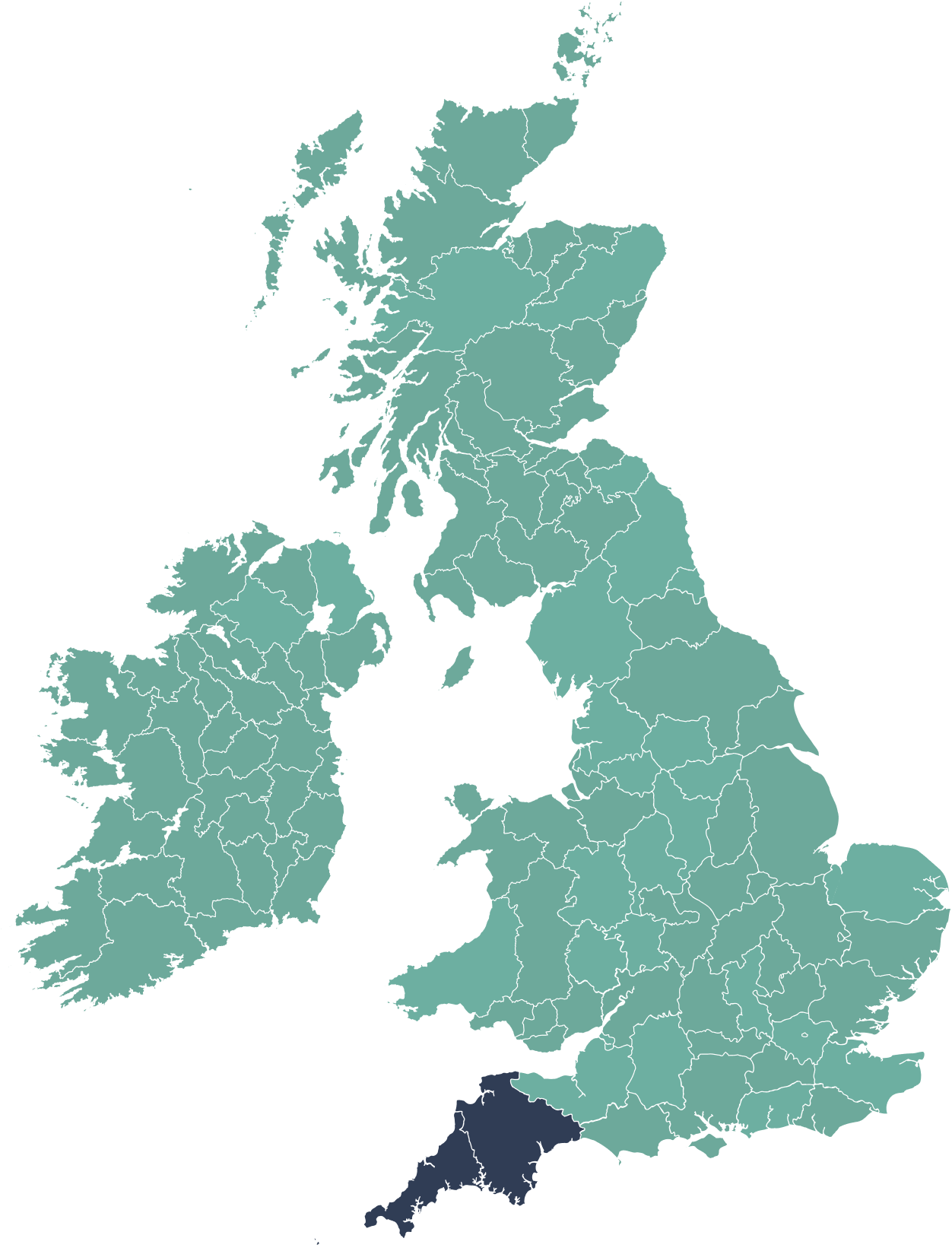
Meet Angie
Angie Cruse is Plantlife’s South West Rainforest Advisor, part of a growing network of rainforest specialists. Angie has a wealth of practical woodland management experience, which allows her to advise land managers on the best woodland management practices for habitat improvement and species recovery.
Angie is essential in the planning and delivery of conservation work in temperate rainforests across the South West of England, as well as training and advising landowners on best practices.
 Angie Cruse, South West Rainforest Advisor © Angie Cruse, Plantlife
Angie Cruse, South West Rainforest Advisor © Angie Cruse, Plantlife
Conservation focus in Winter
Winter work starts with selectively felling trees to open up the woodland canopy, allowing more light to reach the shaded understorey. Halo thinning is carried out around mature and veteran trees, carefully giving them room to grow. Throughout the winter months, the focus shifts to restoring the natural balance of the rainforest by gradually removing non-native conifers in order to promote the growth of native broadleaved trees such as oak, birch, ash, hazel and willow. These native trees, having co-evolved with other species in the rainforest, support a far greater range of wildlife than non-native plantation trees. It’s a hands-on season of hard work, where every action, big or small, contributes to the long-term health of the forest.
Impact
This winter, Coolstays' support has contributed to the restoration of temperate rainforests in the South West by enabling active management to:
- Create more habitat niches, by increasing the number of large-diameter, older trees.
- Improve woodland structure. Many rainforest sites have dense, uniform structures that don't allow enough light. Gradual felling helps create a more complex woodland with a greater diversity of tree species, sizes and ages.
- Create the conditions for rare species to thrive. More open conditions, with increased light, benefit the lichens, mosses and liverworts, which are integral to rainforest habitats.
The 8 globally important lichen communities supported by this project are:
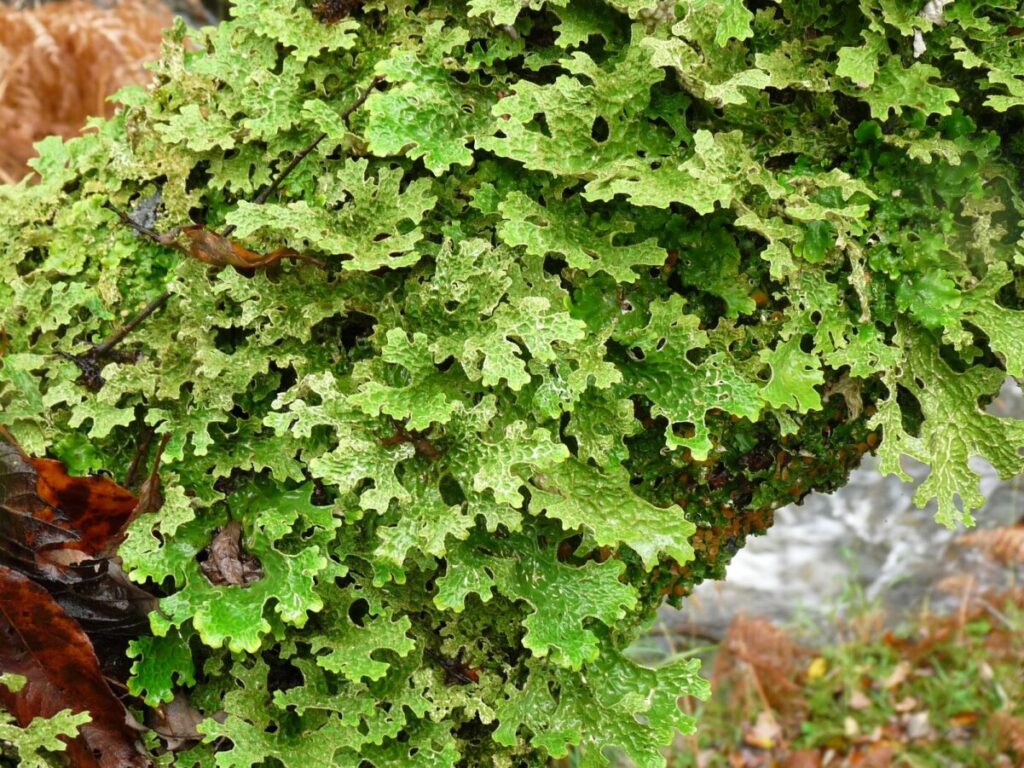
Lobaria pulmonaria
Lobaria pulmonaria or Tree Lungwort. This large, bright green leafy lichen has loosely attached lobes that look like the billowing shape of human lungs, which is where its name ‘Tree Lungwort’ comes from. In medieval times, medics would use Tree Lungwort to treat lung disorders because of its resemblance to human lungs. The Lobarion community grows on trees with mildly acidic or alkaline bark – for example ash, sycamore, willow, rowan and old oak.
.jpg)
Sticta fuliginosa
Sticta fuliginosa or ‘Stinky sticta’ is named after the fishy smell it produces when wet. This lichen has leaf-like lobes, common in lichens within the Lobarion community, and is black-ish brown in colour when wet or dark grey-brown when dry. This species may be one of the most frequently found Lobarian species in Britain’s South West Rainforest and is an excellent indicator of ancient woodlands.
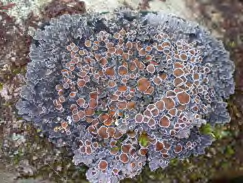
Pannaria rubiginosa
Pannaria rubiginosa, or the Red-eyed Shingle Lichen, has chestnut-coloured fruiting discs and is found on mossy, base-rich trees and rocks. This species is thought to be present in only a few sites in South West England and Wales, however it is a quick coloniser of habitats in Scotland and Ireland. Pannaria rubiginosa is listed as a species which we have ‘International Responsibility’ over as the population in Great Britain is of global significance.
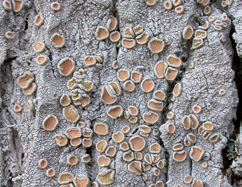
Ochrolechia tartarea
Ochrolechia tartarea is a cudbear lichen within the Parmelion community. It has a thick, warty grey crust with numerous ‘jam-tart’ fruits that are a dull orange-pink in colour. This lichen is used in the production of traditional cudbear dyes.
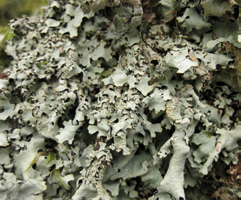
Hypotrachyna taylorensis
Hypotrachyna taylorensis, otherwise known as the Tailed loop-lichen or ‘tumbling kittens’, has blue-tinged overlapping lobes that are often likened to breaking waves. This lichen belongs to the Parmelion community, a group of lichen that occurs on bark, on mats of mosses/liverworts growing over bark or on mossy boulders and rocky outcrops. In Great Britain, this species can only reproduce through bits of it breaking and falling off, as such it can’t disperse very far and is often only found in particularly good quality temperate rainforest sites.
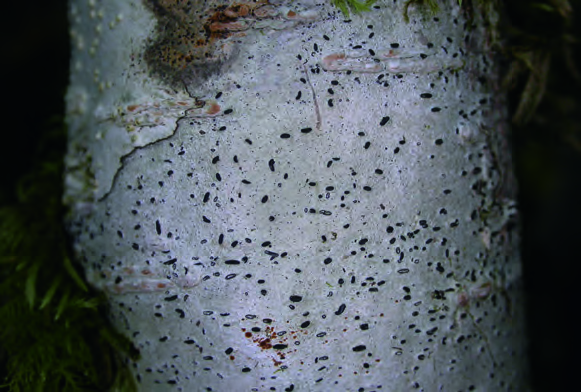
Graphis ruiziana
Graphis ruiziana is a member of the Graphidion community whch is made up of lichens that grow as a very thin crust on the smooth bark of trees such as hazel and holly, usually in moderate shade. If you look closely at these lichens, you will see differently shaped fruiting bodies appearing as dots, flecks, squiggles, warts or pimples on the surface of the lichens. In Graphis ruiziana, the fruit is reminiscent of little black sausages.
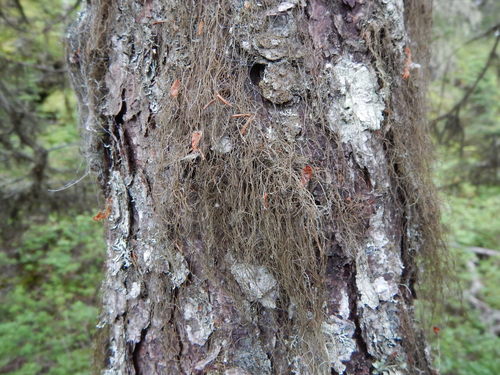
Bryoria smithii
The horsehair lichen, Bryoria smithii, is only known to be present in Britain in two tiny rainforest sites in Devon, where it's believed that the entire population would fit comfortably on two sheets of A4 paper. The species used to be present in Scotland and Wales but has not been seen there for decades. Bryoria smithii is not known to produce fruiting bodies (spores) in Great Britain and instead just reproduces vegetatively, meaning that it can’t disperse very far.
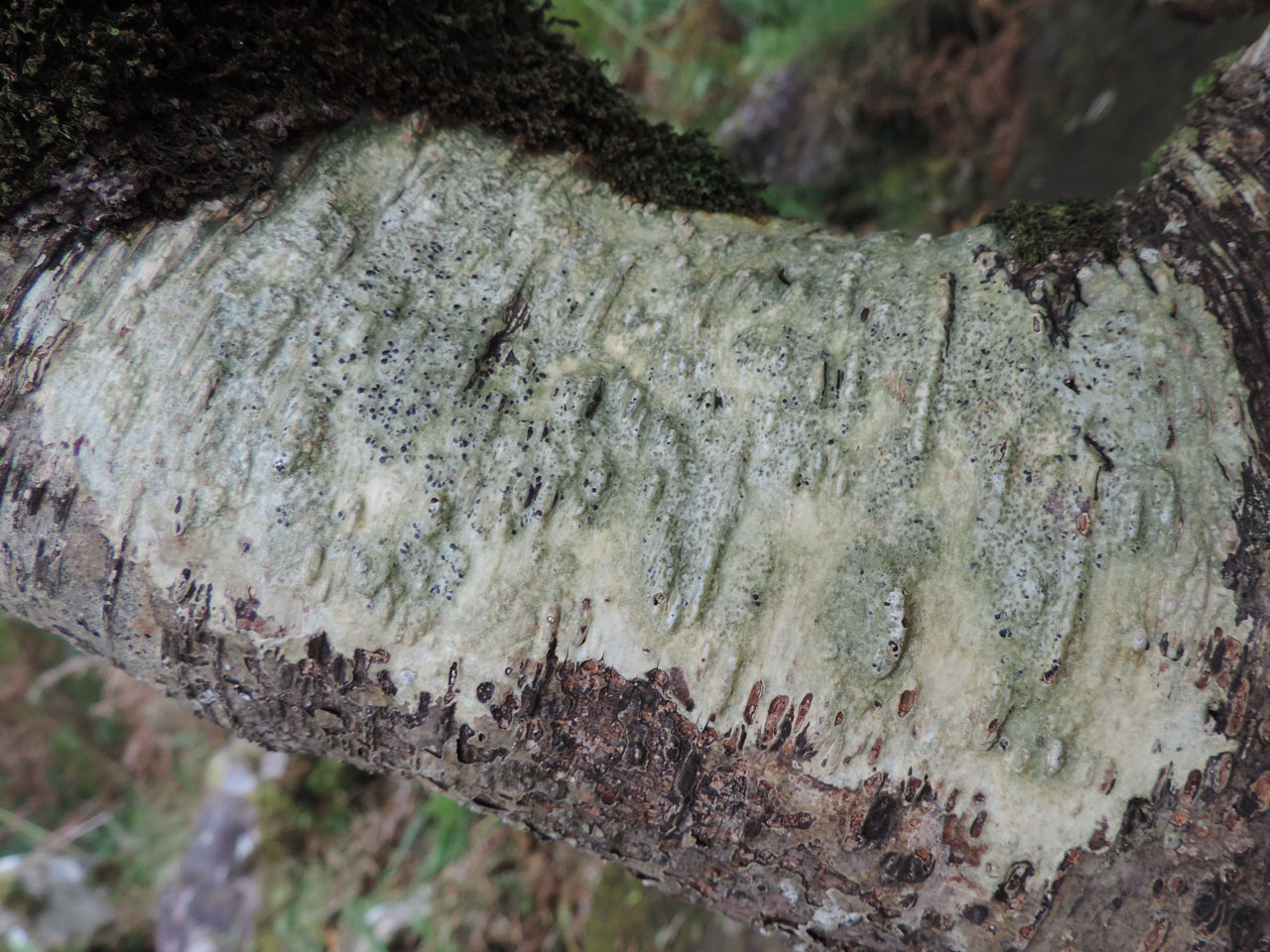
Pyrenula hibernica
Pyrenula hibernica, nicknamed 'blackberries in custard', is a very rare temperate rainforest species, found only in one site in Wales, one in England, a handful of sites in Scotland and Ireland as well as in the Azores and Canaries. This species gets its nickname from its appearance, with a yellow crustose thallus spotted with little black discs called perithecia, it resembles blackberries in custard. It is often found growing on hazel and has such a thick body it can eventually constrict the hazel stem, splitting open as the hazel branch grows beneath it.
Notable native tree species supported by Coolstays across the temperate rainforest sites in the South West include: Ash, Birch, Hazel, Pendunculate Oak, Sessile Oak, and Willow. These species are vital for rainforest diversity as they are important host trees for rare lichens, mosses and liverworts, and their canopies create the conditions for temperate rainforest habitat.


Ash: Fraxinus Excelsior
The ash is the third most common tree in Britain and thrives in rich, fertile soil where it provides a home for woodpeckers and owls. The ash’s leaves, and indeed its whole crown, can move in the direction of sunlight. You have probably heard of ash dieback disease, a fungus affecting both the leaves and crown. It has already wiped thousands of these elegant trees from our landscape, and experts are trying to stop it. Ash is hugely important to many lichen species, so its loss to Ash Dieback is a real threat to many lichens.


Birches: Betula spp.
Birches typically have open crowns and peeling bark, with catkins through the winter months. Their light canopy provides dappled shade, which is important in the context of temperate rainforests, as it creates ideal conditions for mosses, lichens and other ancient woodland flora. Their presence in the composition also increases opportunity for species richness, as their acidic bark offers a different set of niches to that of our base rich trees. Birches are early pioneers, supporting natural regeneration.


Hazel: Corylus Avellana
The common hazel is native to Europe and western Asia and forms an important part of England’s hedgerows. We have all heard of hazelnuts, which are rich in unsaturated fats and protein, and an extremely popular ingredient in many of the world’s cuisines. Did you know that hazel trees were once seen as both magical and a symbol of fertility? Hazel is a very important tree for the script lichens and similar species which like smooth bark. Contrary to popular belief, Hazel does not need to be coppiced, and should be left to grow naturally and undisturbed in rainforest habitats.


Pedunculate Oak: Quercus Robur
Also known as the common or English oak, this is the undisputed king of the woods, supporting more wildlife species than any other native tree in the UK. “Robur” in this oak’s Latin name means “strength” and “hard timber” because this tree produces incredibly durable wood which can be used to make many things, including furniture and flooring. The oak has been considered sacred by many gods in mythology throughout the ages.


Sessile Oak: Quercus Petraea
The sessile oak is Ireland’s national tree and can be found across Europe. Sessile means “without a stalk”, and this tree’s acorns are stalkless, growing directly on twigs. Oaks provide a habitat for many creatures, including red squirrels, badgers, jays, caterpillars and around 250 more species of wildlife.


Willows: Salix spp.
Willows are known for their slender, flexible branches, lance-shaped leaves, and quick regrowth. They thrive alongside rivers and in other damp environments, such as temperate rainforests, due to their tolerance for very wet and heavy soils. Their bark, which is less acidic than other species, makes them good hosts for species of lichens which prefer higher pH and mossy substrates.

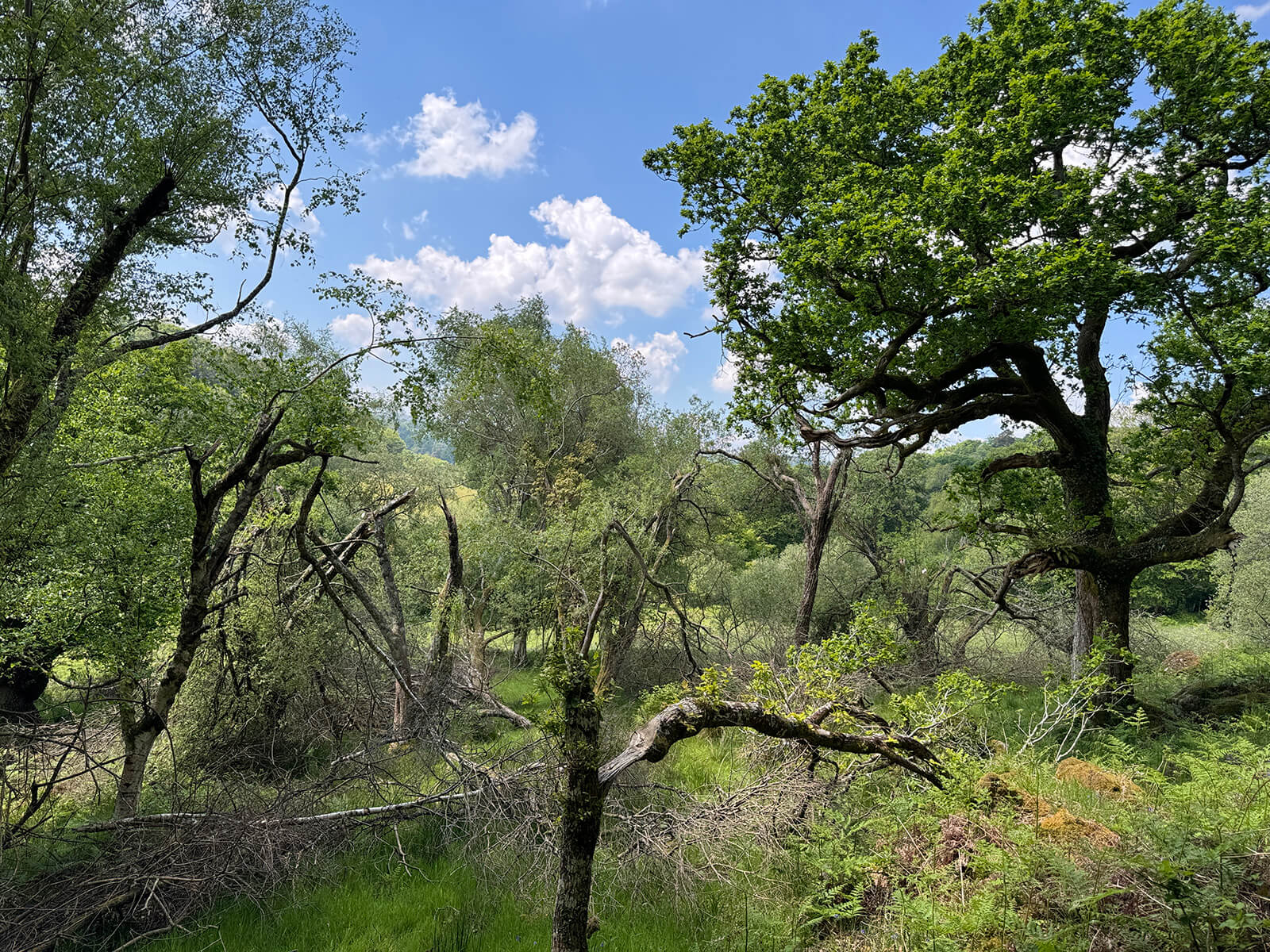 Thinning work (non-felling techniques) © Angie Cruse, Plantlife
Thinning work (non-felling techniques) © Angie Cruse, Plantlife
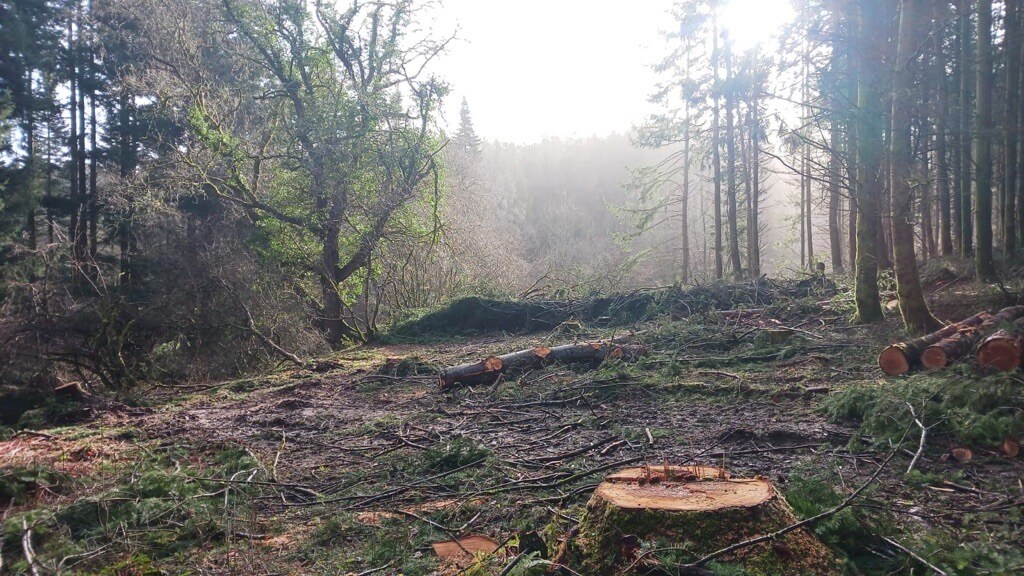 Conifers removal © Angie Cruse, Plantlife
Conifers removal © Angie Cruse, Plantlife
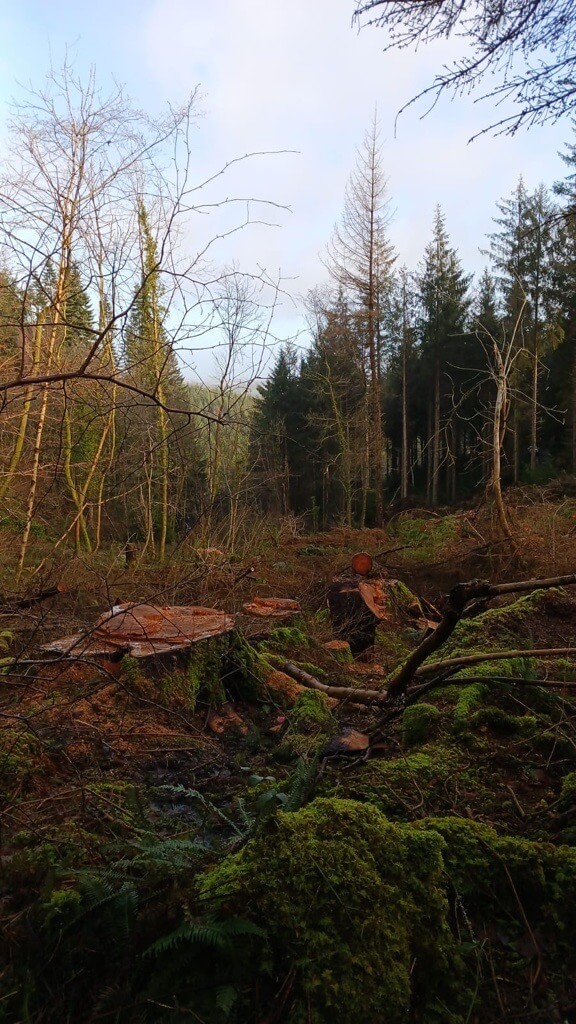 Conifers removal © Angie Cruse, Plantlife
Conifers removal © Angie Cruse, Plantlife
 - Angie Cruse.jpg) Holly (after) © Angie Cruse, Plantlife
Holly (after) © Angie Cruse, Plantlife
 - Angie Cruse 1.jpg) Holly (before) © Angie Cruse, Plantlife
Holly (before) © Angie Cruse, Plantlife
 - Angie Cruse.jpg) Holly (before) © Angie Cruse, Plantlife
Holly (before) © Angie Cruse, Plantlife
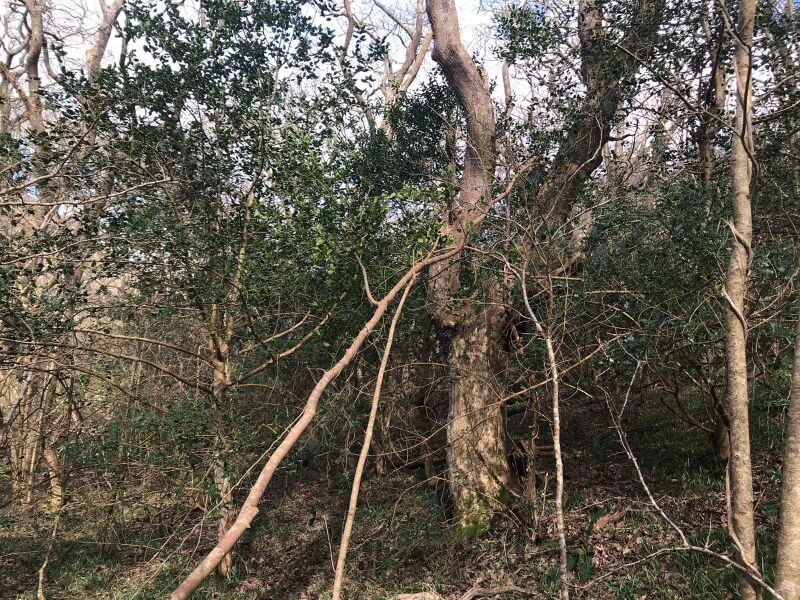 Dense holly (before management) © Angie Cruse, Plantlife
Dense holly (before management) © Angie Cruse, Plantlife





